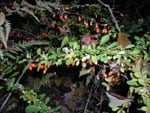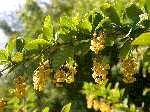Reprinted with the author’s permission from the Spring 2011 issue of Sanctuary, Journal of the Massachusetts Audubon Society.
by Russ Cohen
A few of our naturalized alien plants were first brought over to this country for their culinary value. They were then overlooked and some escaped into the wild; European barberry and garlic mustard are two examples.
Barberries were we ll known and appreciated by Massachusetts households of the Colonial and subsequent periods. According to an article that appeared in the periodical New England Farmer in the early 1800s, “Barberry jelly, ruby clear, is the finest table jelly to serve with venison and other high-flavored roasts, and epicures will have no other when they have once tried it.” New England housewives often put barberries into the jars of other preserved fruits to add a tart flavor, and Henry Thoreau observed the townspeople going out to pick them as early as mid-September before they were fully ripe to gather the fruit first.
ll known and appreciated by Massachusetts households of the Colonial and subsequent periods. According to an article that appeared in the periodical New England Farmer in the early 1800s, “Barberry jelly, ruby clear, is the finest table jelly to serve with venison and other high-flavored roasts, and epicures will have no other when they have once tried it.” New England housewives often put barberries into the jars of other preserved fruits to add a tart flavor, and Henry Thoreau observed the townspeople going out to pick them as early as mid-September before they were fully ripe to gather the fruit first.
Barberry plants can still be found growing alongside 18th- and 19th-century farmhouses and rural roads. A good time to locate the bushes is in May, when they are covered with clusters of yellow blossoms with a heavy and somewhat unpleasant scent. The blossoms are followed by deep red berries that ripen in the fall and typically persist on the bushes into the winter, and occasionally into the following spring. (One year I made barberry jelly in May from the previous season’s berries that were still clinging to plants that had already begun to flower.)
European vs Japanese Barberry
Before extolling the culinary virtues of the common, or European, barberry (Berberis vulgaris), it is important first to distinguish it from the nefarious Japanese barberry (Berberis thunbergii), a plant at or near the top of the invasive species blacklists. Japanese barberry has become a serious pest in southern New England, especially in old fields, pastures, and early successional woodlands. In the Berkshires, it invades and degrades rich woodland habitats relied upon by spring ephemeral wildflowers and rare plant species, and it’s also a serious problem in the forests of Quabbin Reservoir in Massachusetts. Japanese barberry is easy to distinguish from European barberry once you know what to look for. Japanese barberry rarely gets over 3 to 4 feet tall and has small, untoothed leaves and a single spine beneath each cluster of leaves. Its orange-red berries are borne singly on the underside of the twigs.
In contrast, European barberry typically grows 6 to 8 feet tall, has toothed leaves, and two- or three-branched spines beneath each cluster of leaves. Its egg-shaped, centimeter-long, deep red berries hang in drooping clusters of a dozen or so and are much juicier and tastier than Japanese barberries, which tend to be dry and bitter. One way to remember which is which is that Japan is just one country, thus singly borne berries, whereas Europe is many countries, thus berries borne in a cluster. (To complicate matters, however, these two species occasionally hybridize and the resulting plant bears some resemblance to both.)
The berries are ripe and at their juiciest in mid-autumn. If you are able to extract enough juice from the berries for a batch of jelly without adding water by heating them in a crock and squeezing the juice out of the softened berries, you will find that they contain enough pectin to make jelly. If, however, you wait to gather them until the shriveled but still highly flavored fruit looks like little red raisins, you will need to simmer them in a little water first for a half-hour or so. Remove the seeds, which resemble the small pegs once used in shoemaking, by pouring the resulting product through a sieve, and combine it with crab apple juice or use commercial pectin to get it to jell. With an equal bulk of sugar to juice, barberry makes a very tart, distinctly flavored jelly. Barberry juice adds a red color and tart flavor to apple juice, applesauce, and stewed Japanese knotweed stalks.
Garlic Mustard
Another plant species believed to be deliberately brought to our shores from Europe for its culinary and medicinal values is garlic mustard (Alliaria petiolata), so-called because the leaves when crushed give off a distinctive garlicky smell. This aroma divulges no indication of the plant’s lineage since the species is not even distantly related to garlic or onions (in the genus Allium) but is in fact a member of the mustard family (Brassicaceae).
If you’ve heard of garlic mustard, it’s probably not for its comestible or medicinal qualities but for its notorious (and, unfortunately, well-deserved) reputation as a highly invasive, rapidly spreading, and ecologically disruptive species throughout much of the US. Nonetheless, its habit of remaining green throughout the winter made it especially useful to people in days of yore before refrigeration and the modern produce distribution system made green vegetables widely available throughout the year.
While it is possible that garlic mustard found its way here on its own (hitching a ride on a ship in a bale of hay), given the plant’s extensive usage in England and elsewhere in Europe, it is very likely that it was deliberately brought here for planting in kitchen and herb gardens. After all, the same edible and useful traits (especially the availability of the green leaves in late winter and early spring when few other green vegetables were available) would be as valuable to the settlers here as they were to them in the Old Country. At least two native species, marsh marigold (Caltha palustris) leaves and ostrich fern (Matteucia struthiopteris) fiddleheads, as well as the European import wintercress (Barbarea vulgaris), were also extensively appreciated as early-season sources of green vegetables.
Many environmental agencies and organizations have declared war on garlic mustard and are seeking to raise public concern and alarm about the plant’s spread. While some control methods utilize cutting, burning, or herbicide spraying, a commonly employed control method is hand-pulling. This is typically done in the spring, after the plants have begun to flower but before the plants have produced viable seed.
A staff member at the Kalamazoo Nature Center in Michigan (whose grounds are afflicted with a garlic mustard infestation), who sought to raise public awareness of the issue and recruit volunteers for its garlic mustard pulls, approached chefs at various restaurants in the city to see what dishes they could concoct with the invasive species. The tasty results were compiled in From Pest to Pesto: A Culinary Guide, published by the nature center.
Making Garlic Mustard Palatable
Most parts of garlic mustard have a pungent flavor that is too strong for most people to enjoy when eating the plant in its raw state. Nevertheless, you can collect tender garlic mustard basal leaves or the clusters of flower buds in the spring and boil them for several minutes (at least) to tone down the plant’s bitterness to a tolerable level, pour off the water, and then eat it as is. While still somewhat bitter, it will not be intolerably so and you can incorporate it into other dishes. Garlic mustard roots taste horseradish-like and can be used as a substitute for that pleasantly bitter root.
The most palatable parts of the garlic mustard plant, which do not require parboiling, are the tender portions of developing stems of second-year plants when they’re less than a foot tall and before the flower buds form. The plants are typically at this stage in Massachusetts around the last week of April into early May. The stem is relatively mild and tender enough to be eaten raw, and also lends itself well to a quick stir-fry or a chopped-up ingredient in soups.
You can achieve two objectives (culinary and ecological) at once by hand-pulling the entire plant out of the ground, snapping off the tender portion of the stem, eating it (or saving it for later), and then placing the remainder of the plant (roots, leaves, and all) into a plastic garbage bag for disposal. It is strongly advised not to put garlic mustard directly into compost since the plants may not be effectively neutralized. You can put the plant material into black plastic bags and leave them for a good amount of time (several weeks or so) in a warm location so that the insides of the bags get thoroughly cooked and decomposed—then the bags’ insides can be safely added to the compost bin.
About the Author
Russ Cohen, environmentalist and wild foods enthusiast, enjoys nibbling on and promoting the planting of edible native species. He is the author of Wild Plants I Have Known…and Eaten (Essex County Greenbelt Association, 2004) and has written a chapter on edible natives for Brooklyn Botanic Garden’s soon to be released booklet on native plants. Russ has taught edible wild plant and mushroom courses throughout New England for more than 30 years. He also serves as the Rivers Advocate for the Division of Ecological Restoration of the Massachusetts Department of Fish and Game.





